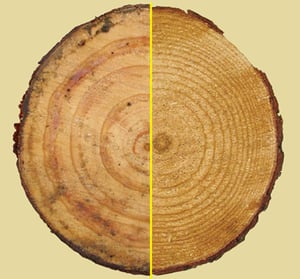Rural fencing has been a traditional trade for many years in New Zealand and is often a topic of conversation among farmers, often with robust discussion because a good fence is the difference between keeping livestock in the right paddock or not. It's one thing to have good gear like our Rata Log Forks to build a good fence, but to last the test of time it often comes down to the materials fencing crews or builders use. Here we talk particularly about the timber that should be considered before purchasing, before you build a good quality and enduring rural fence.
It's interesting to note that high density posts don't come from every corner of our country and unsurprisingly the growing conditions that the Nelson region has, produces some of the country's highest density trees. The climate and slow growing nature means that there's more carbon per square inch and the growth rings are tightly compact, an indication of the timber being high density.
In the below cross section you can tell the stark difference between timber that has fewer growth rings and wide spaces between each growth ring, as in the left hand side example. This is an immature and weak log and could be only from forestry tree thinning. On the right hand side however, we have timber cut from a mature and strong tree, this has over twenty tightly packed and even growth rings, making it very robust and ideal for a strong post.

So timber density is something that you visibility gauge when choosing good posts. What's not so easy to determine is the treatment process that the posts have gone through in view of guarding the post against fungal and insect attack.
It's always good to purchase timber products from a company that have a guarantee and have an understanding that there haven't been any shortcuts taken. The basic process of treating posts and poles is highly controlled and consistently monitored. The posts are peeled and steamed and then loaded into a large treatment cylinder.
The cylinder door is hermetically sealed and a strong vacuum removes the majority of the air from the cylinder and from the cells of the timber. Chemicals like CCA (copper chromium arsenic) are formulated and applied with hydraulic pressure to the cylinder and then the excess solution is removed with vacuum, leaving the chemical impregnated into the timber, to react and within days the chemical is leach resistant.

%20(1).jpg)
.webp)